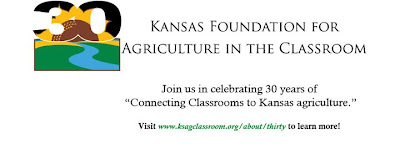Sometimes it's heavy lifting - literally and figuratively. With Randy unable to lift anything more than 10 pounds for the next three months, a neighbor is helping Jake with some of the chores as Randy recuperates.
One of my long-time farm friends, Mary Anne Stoskopf, asked me if she could include some of my blog entries and photos in the new Kansas Foundation for Agriculture in the Classroom Exploring Plants: Kansas Crops Educator's Guide.
I recently received my copy, and, after looking at the 231-page edition, I am even more honored to have been asked to contribute. It is the model of collaboration, with dozens of people providing photos and information.
Each unit introduction includes a writer from the past, and one from the present. Here's a little of what John James Ingalls, U.S. Senator, 1873-1891, had to say in the Kansas Overview:
This is a day when it is a pleasure to be alive. The sky is intensely blue and cloudless, save for a few white wooly cumuli that be piled idly along the northern horizon above the green hills that divide the waters of White Clay and Independence creeks. A scarcely perceptible breath blows from the west. The grass glitters in the sun. Dimly visible beyond the great curves of the shining river, veiled in amethyst, are the bluffs of St. Joseph and the trailing plumes of smoke from its towers. The hyacinths, red, white and blue, dazzle the eye like flame on the eastern lawn, and crimson tulips in another bed emulate their fragile glory.And here's a snippet from my blog, Sea Change, May 28, 2010:
John James Ingalls
Poets wax poetically (as poets are wont to do) about the beauty of the ocean - the waves breaking on the beach, the roar as the water washes over rocky cliffs, the bluest of blue hues, the ebb and flow as water surges and retreats. ...It was exciting to see that blog entry, as well as another I wrote about silage harvest, included in the book, along with a few of my photos.
The wheat is our Kansas ocean. It ripples across the prairie with peaks and valleys generated by the southerly Kansas wind. As I walk along the County Line, I hear the whisper of the wheat stalks as they brush against their neighbors. Instead of hearing the screech of gulls at the shore, I hear a symphony of Kansas song birds trill out a morning greeting.
Kim Moore Fritzemeier, May 2010
I'm not telling you about it to toot my own horn. Instead, I want educators (and others) to know it's available. Every so often, a teacher friend tells me that she learned something from a blog post about farming. She didn't grow up here, and she doesn't have an agricultural background. It always makes me feel good to know that my little corner of the internet provided some accurate knowledge about modern agriculture and the whys and wherefores that help us make decisions on our farm.
But my contribution pales in comparison to this comprehensive review that explores Kansas crops.
Kansas agriculture is incredibly diverse and complex, just like the crops grown on Kansas farms and ranches. From asparagus and corn to turfgrass sod and wheat, our goal is to assist educators and advance the understanding of the plants we grow in Kansas and how those plants provide food, fiber, fuel and other products for people in Kansas and around the world.Kansas educators can order the spiral-bound book at a minimal cost, basically what it costs to ship. (They are available to others at a higher cost.) There are free online lessons plans available to then use this book - and other Kansas Ag in the Classroom materials - most effectively in the classroom. It's not about using these lessons in a vocational agriculture class. Educators can use these lessons to teach math, social studies, geography, nutrition, health, ... the list is as diverse as Kansas crops.
Mary Anne Stoskopf, ChairPlants Guide Working GroupKansas Foundation for Agriculture in the Classroom
Kansas Foundation for Agriculture in the Classroom has been connecting classrooms to the ag community for 30 years. As a producer, I'd like to thank them for their commitment to this mission.
Check out the Kansas Agriculture in the Classroom website, whether you're an educator or not.




Thank you so much for the wonderful blog post! We are so appreciative of your contributions and support of KFAC!
ReplyDelete-Sheridan Wimmer, KFAC Program Assistant
I really am honored to have been included.
DeleteInteresting book plug Kim. JJ Ingalls is who our little town is named after where I teach. Funny coincidence. Congrats on being included in this publication.
ReplyDeleteKeep up the good work.
This Little House on the Prairie fan kept thinking it would be neat if the comparison was Charles Ingalls, though I don't know that writing was among his talents. But then again, I can't play the fiddle. I didn't realize the connection to Ingalls, Kansas. Thanks for sharing that tidbit and also for taking time to comment.
Delete